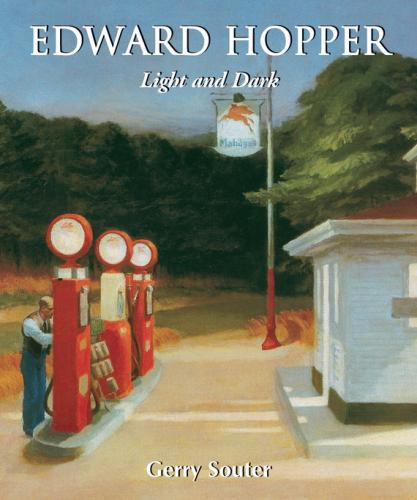After building up his relative wealth into the black, Hopper needed to blow off steam. An artist acquaintance, Bernard Karfiol, recommended the Maine seaport village of Ogunquit, a popular nesting place for New York artists who descended on it each summer like a flock of seagulls. For eight dollars a week, Hopper became a guest at the Shore Road boarding house favoured by the artist population and sat down with them to a communal supper table where he met a fellow resident, a short redhead named Josephine Nivison whom he had seen in Henri’s classes. The instructor had, in fact, painted a full-length portrait of her costumed in paint smock gripping her palette and brushes titled Art Student. The village became a gathering place for many of Hopper’s schoolmates and all the old stories blossomed to life around the dinner table and afterwards.
He plunged into a series of paintings in his usual 29” × 24” size canvases that again demonstrated his ability to make so much out of so little apparent effort. The coastal coves are revealed under a bright sun that bathes the bays creating deep shadows and flat blue seas beneath the anchored brush-swipe dories. Two paintings distinguish themselves from the sea-washed cliffs and coves.
35. Railroad Sunset, 1929. Oil on canvas, 74.3 × 121.9 cm. Whitney Museum of American Art, New York, Josephine N. Hopper Bequest.
One is Rocks and Houses that sits beneath a stratus-cloud sky. In the somewhat flatter light, the houses with their deep eaves and gambrel roofs crouch behind an enormous rock, rounded with age and festooned with shrubbery at its base. The feeling is one of compression and melancholy. The houses are intruders on an ancient landscape. Another painting is Road in Maine, the simple view of a rural road winding back in an S-curve behind a rocky outcropping. Only the top part of the curve is visible as it disappears around the corner, its shoulder punctured by two utility poles. The light is sunny, the sky is clear, and yet the mood suggests something has just passed this way or is approaching. The theme would return later in his work.
Returning from Ogunquit he had quite a lot to show for his time away from the illustration trenches. Once back, he found different trenches waiting. His magazine clients had lined up a number of projects including imagined World War I scenes from Everybody’s Magazine showing bloody and brutal combat action of which he knew nothing.
The Montross Gallery on Fifth Avenue above 49th Street proposed a show and Edward was invited. Full of optimism, he offered up his latest work, Road in Maine. Guy du Bois placed four of his own works and singled out his old chum Hopper’s piece for comment in Arts and Decoration Magazine – of which he was editor. He used the terms: “austerity and baldness”, citing elimination of detail in the extreme, the “wireless” telephone poles, the “bleak” country and pointing out the “barren” road. Sounding almost like a slap, du Bois saved the review at the end with the “warmth and colour that ring with sincerity and truth” and a parting pat on the back: “This is where the painter has returned more than he has taken away.”
The left-handed effusiveness aside, du Bois’ mention comes close to getting inside Hopper’s head and seeing in its infancy what would become a primary drive in the artist’s choice and rendering of future subjects.
Hopper did not find the experience amusing. He failed to sell the painting. He was also keenly aware of a previous show of Maine paintings by George Bellows who was singled out as “…following in Winslow Homer’s footsteps…like Rockwell Kent.”[14] Many of his former schoolmates were getting good press, advancing into sales and one-man shows – even if some were achieving success by being compared to already successful artists. Hopper did not desire to follow in anyone’s “footprints”.
Pressing on, Hopper presented himself at the MacDowell Club with two canvases in February 1915. The oil New York Corner is, for Hopper, an explosion of human activity around the ornate gold and gilt façade of a corner saloon. Its composition is an academic balance of foreground, middle ground and background that is anything but lively. The figures are dressed in workers’ black, trudging toward a newspaper kiosk that is also beneath the saloon’s overarching portico. The effect – with the rounded pavement kerbs – is of carved figures on a moving platform forever circling across the face of an antique clock. It is Hopper’s virtuoso ability to spike in elements of colour and light with simple brush dabs: the newspapers, the highlight on the foreground gas lamp, the gilt decoration above the door and the barber’s pole that adds life to the urban solidity of the brick building and distant cityscape.
Конец ознакомительного фрагмента.
Текст предоставлен ООО «ЛитРес».
Прочитайте эту книгу целиком, купив полную легальную версию на ЛитРес.
Безопасно оплатить книгу можно банковской картой Visa, MasterCard, Maestro, со счета мобильного телефона, с платежного терминала, в салоне МТС или Связной, через PayPal, WebMoney, Яндекс.Деньги, QIWI Кошелек, бонусными картами или другим удобным Вам способом.
